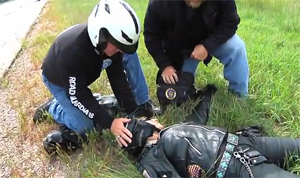What Should Be at Motorcycle Rider First Aid Kit
You never know when an accident could happen. On the road, it could involve you or someone else. So, it is best to be prepared on anything you may encounter through your ride.

Of course, you cannot just attend to someone who got injured. You have to access the extent of the injury and call the paramedics. However, if it is just minor injuries such as bruises, burns, or cuts, you may give the first intervention to the wound.
When packing your Motorcycle First Aid Kit, don’t forget the items that you can use on injuries a motorcycle rider commonly experience. The list of injuries includes:
- Burns– it can be sunburn, heat burns or burn from exhaust pipe
- Eye injuries– it may include flying insect into the eyes
- Cuts, bleeding, and abrasions – you or other riders can sustain from hitting the pavement
- Fractures – from crash or impact
It is important to know the purpose of every item on your motorcycle first aid kit and how to use them. Otherwise, they are just useless stuff in your baggage.
What should go in your Motorcycle First Aid Kit? Here’s a checklist.
- At least 2 pairs of Nitrile or Latex gloves
- Anti-microbial hand cleaner – at least 60% alcohol
- Sting relief and burn gel or cream
- Band-Aids
- Steri-strips or butterfly bandages and adhesive sutures- to pull a small gaping cut or wound together
- Triangular bandage – for slings, padding, strapping limbs to splints when fractures are suspected
- Instant Cold packs
- At least 4 large 4×4 sterile gauze pads
- Feminine pads – great alternative for stopping heavy bleeding
- Antibiotic ointment
- Medications – such as anti-diarrhea tablets, anti-acid, antihistamine, pain relievers, electrolytes.
- Sterile saline with a squirt tip for irrigating – this can also be used as eye wash or wound cleansing
- Glow sticks – for directing traffic or signaling for help
- Heavy duty zip-lock bags
- Emergency blanket – for retaining body heat, a reflector for rain, and ground cover
- Tweezer for splinter removal and other first aid procedures.
- Curved scissors – useful in cutting clothes away from an injury
- Mobile phone and emergency hotline numbers
It is recommended to pack these items in separate strong zip-lock bags according to their type. You can put all medications in one zip-lock bag. The gauze, pads, bandages, etc in another and medical tools such as scissor and tweezer in another. All will go in another container, preferably a waterproof bag.
It is good to bring your first aid book or cheat sheet with you every time. However, you will not have time to consult your first aid manual during an emergency. Thus, experts recommend taking an Accident Scene Management (ASM) course to learn about the first aid challenges you may encounter on the road and how to treat them.
Sources:
https://roadguardians.org/a-motorcycle-first-aid-kit-has-special-needs/
http://www.firstaidanywhere.com/motorcycle-first-aid-kit.html



